|
|
 |
Canadian Historic Sites: Occasional Papers in Archaeology and History No. 26
St. Andrew's Presbyterian Church, Lake Bennett, British Columbia
by Margaret Carter
Founding a Mission
In 1897 the Reverend J.M. Dickey, Presbyterian
minister in Skagway, marked Bennett as the next logical centre of
population. A town was already forming — a collection of tents on
the south end of Lake Bennett at the junction of the Chilkoot and White
Pass trails. Although many routes "inside" were publicized during the
days of '98, these were both old Indian routes, and the Chilkoot had
been used by white prospectors in the north for many years. They were
undeniably the most popular for men who could not afford exorbitant
steamer rates to travel the whole journey by water through the mouth of
the Yukon River. They could be reached by commercial steamer from the
south, but at the neck of the Alaskan panhandle a long self-propelled
trek began.
Although the Chilkoot and the White Pass (Fig. 1)
were regarded as the best trails, they were both arduous. The Year
Book of British Columbia written for publication early in 1898
outlined the latter this way:
WHITE PASS
The White Pass commences at Skagway Bay at the head
of Lynn Canal at which point ocean steamers may call and where a wharf
has been built for the accommodation of shipping . . . The first
four miles is an easy water grade to Four-Mile Flat, to Porcupine Creek,
up and down the side hill, is five miles; from there it is three miles
to the first bridge on the Skagway River; it is swampy for a mile and a
half to two miles to the second bridge; from there to the third bridge,
one and a half miles, there are some hills and swamp land; to the
Crossing by the Skagway is three quarters of a mile on foot, but by the
trails for pack animals it is three miles along what is known as 'Bad
Hill'. From the Crossing to the Summitt to Lake Bennett twenty-two
miles. The trail leads along the southern side of Summit Lake and
Shallow Lake to Government House and from there touching Lake Lindeman
to Lake Bennett. 1
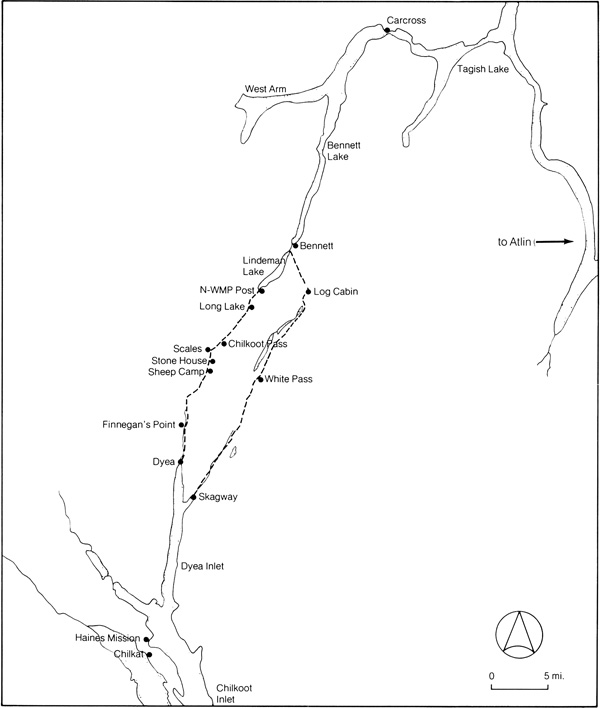
1 The Chilkoot and White Pass trails.
(Map by S. Epps) (click on image for
a PDF version.)
|
Edwin Tappan Adney, who travelled the route late in
1897 gave a more graphic description.
Gradually, stage by stage, the trail rises,
following the sloping shelves of the bare rock, so smooth as to afford
no foothold . . . Where there are no rocks there are boggy holes.
It is all rocks and mud — rocks and mud.2
Animals and men often went lame on the trail
(Figs. 2 and 3). They were exhausted when they reached Bennett.

2 An Hourly Occurrence
(Sinclair Papers.)
|
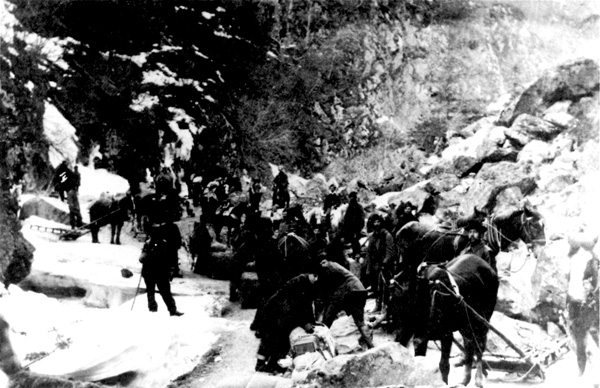
3 Blockade, White Pass Trail.
(Sinclair Papers.)
|
The Chilkoot was somewhat quicker, though no less
tortuous. It was an old Indian trail and "has always been the best in
summer,"3 explained one veteran Mountie. Unfortunately in
1898 most Klondikers travelled in the spring to reach the diggings in
time for a full season. There were so many of them that the steps
carved in the ice on the mountain side by Al Lobley
and Sam Taggart4 thawed (Fig. 4), and the presence of
would-be miners helped set off three avalanches in an already
avalanche-prone area (Fig. 5). Nevertheless, one guidebook gave
adventurers the following dispassionate description of the route:
DYEA OR CHILKOOT
From Dyea landing to the Canon is eleven miles, practically on the
level of the Dyea River flats; from the Canon to Sheep Camp is a hilly
trail five miles long, reasonable passable. Up to the Scales, three
miles, is steep and rough and the trail bad. From the Scales to the
Summit, which is an altitude of 3,700 feet, is a distance of
three-quarters of a mile, very steep and impassable for pack animals.
The distances, with bad trails all the way, with the exception of the
last mile, upon which waggons are used from the Summit are as follows:
To Crater Lake, three-quarters of a mile; Crater Lake, two miles; to
Portage, two and a half miles; to Lake Lindeman, five miles; to Lake
Bennett, one mile.5
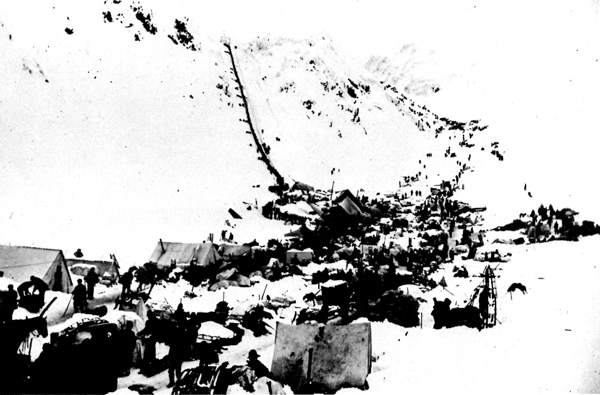
4 White hundreds of men waited to start up the Chilkoot Pass, those
on the thin black line were climbing the steps.
(University of
Washington.)
|
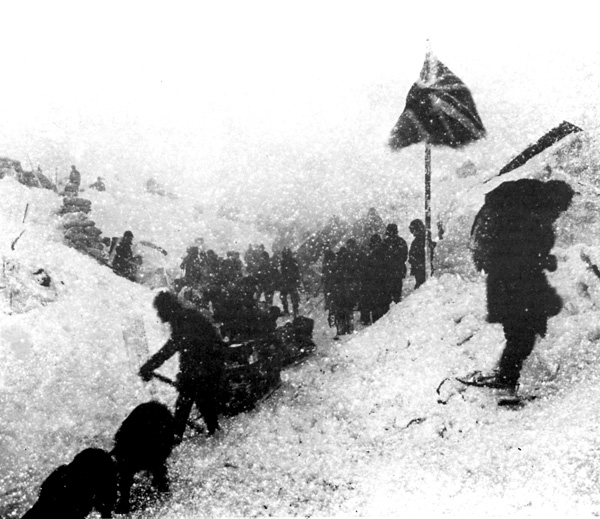
5 Snowstorm on Chilkoot summit, 1898.
(University of Washington.)
|
Despite its apparent difficulties,
the Chilkoot route was very popular. Martha Black reported that in July
of 1898 "the young officer told me that since the previous May eighteen
thousand men had passed the pass and I was the six hundred and
thirty-first woman"6 (Fig. 6). By the early spring of 1898 a
tramway had been built over the mountains to carry goods to Crater Lake
on the other side. Indian packers also sold space in packs like those
shown in Figure 7, but both of these services were expensive, and most
Klondikers carried goods to Bennett themselves (Fig. 8).
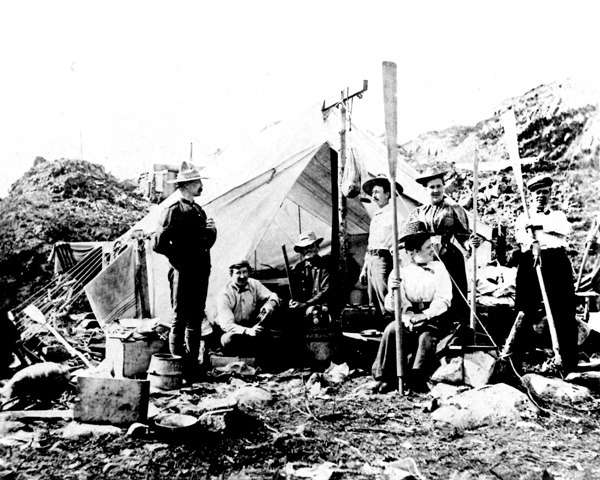
6 En route to the gold mines.
(Yukon Archives, MacBride Museum
Collection.)
|
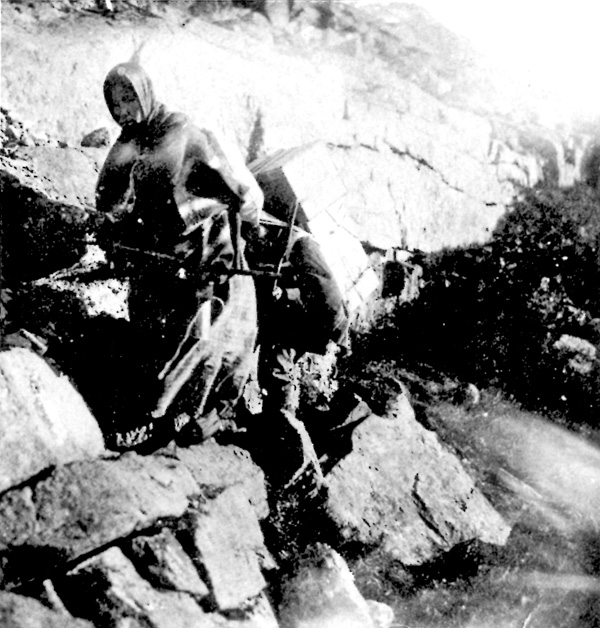
7 Indian packers carrying heavy loads.
(Missouri Historical Society.)
|
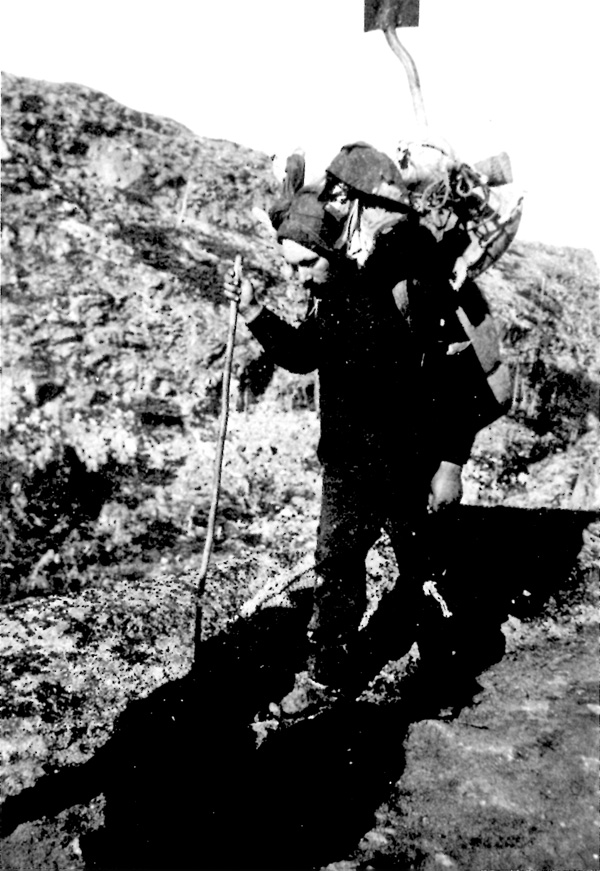
8 A Klondiker totes his own load.
(Missouri Historical Society.)
|
Bennett marked the end of the trails, but these
comprised only the first lap of the journey to the gold-fields on the
southern route. The rest of the journey from Bennett to the Klondike was
made on the Yukon River itself (Fig. 9). During the winter when the
river was frozen, men continued their journey by sled. Hazardous
conditions near Miles Canyon and the Whitehorse Rapids made the second or
river half of the journey as exhausting as the early trail portion, so
Bennett grew as the half-way resting point.
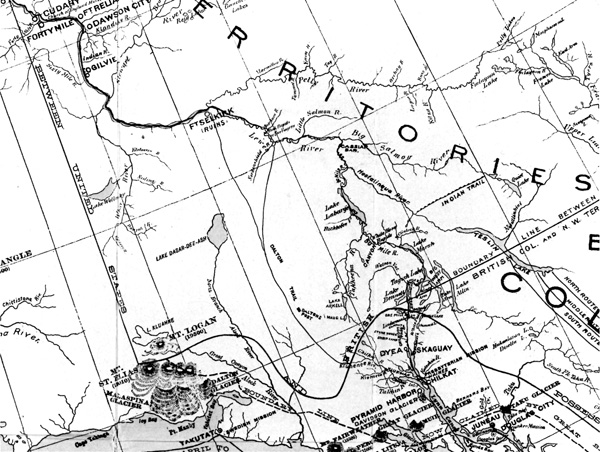
9 Bruce's Map of Alaska (New York and London: G.P. Putnam's Sons,
1899). Section only.
(Contained as an insert in Mary E. Hitchcock,
Two Women in the Klondike [New York: G.P. Putnam's Sons, 1899].)
|
A crude centre appeared at the southeast end of the
lake as men pitched tents and took up temporary residence (Fig. 10). By
September of 1897 a sawmill had been built near the "settlement" to
provide lumber for boat-building,7 and tent stores had been
erected to buy outfits from discouraged men returning home and sell them
to the hopefuls on their way north. Canvas beaneries and saloons were
also set up. In response to this activity, the Reverend James
Robertson, Superintendent of Home Missions, decided to act on Skagway
minister Dickey's recommendation and establish a mission at Bennett.
Consequently, the second Presbyterian minister to the Klondike, Rev.
Andrew S. Grant from Almonte, Ontario, arrived in Skagway on 22
January 1898, and moved straight inland (Fig. 11). He reached Bennett in
mid-February and reported to Robertson that the journey on the White
Pass had been "the herculean task of my life."8 His comments
were similar to those of the thousands of other gold-seekers accustomed
to city life who made the trek north. "The trail is a brute," he wrote,
"but thanks to the Lord we have conquered it, and our stuff is all over
here. It would have cost our party $1,800 to have our stuff freighted
over and we took it ourselves in three weeks."9 The task
meant doubling back again and again to carry the heavy outfit along the
trail (Fig. 12). A large supply of staples had been required by the
North-West Mounted Police for entry into the country since the previous
winter when Dawsonites had almost starved to death. This made travel
quite a hardship, but it was only one of many the ordinary Klondiker had
to brave. "It is not the most comfortable thing sleeping on the snow 40°
below, and doing our own cooking but we are all right."10
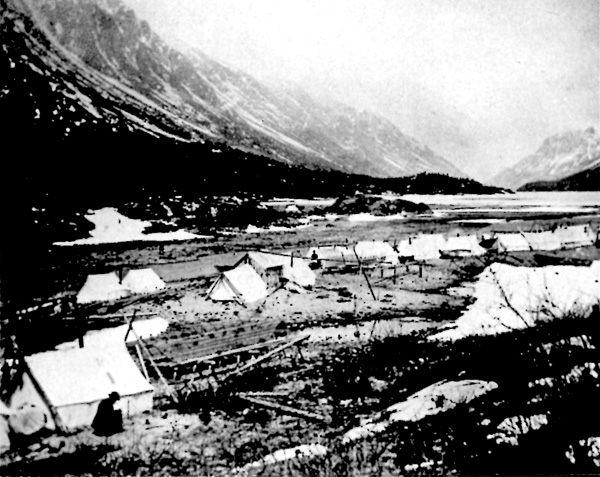
10 Boat-building camp, Bennett, 1897 or very early 1898.
(R.N.
DeArmond, Juneau.)
|
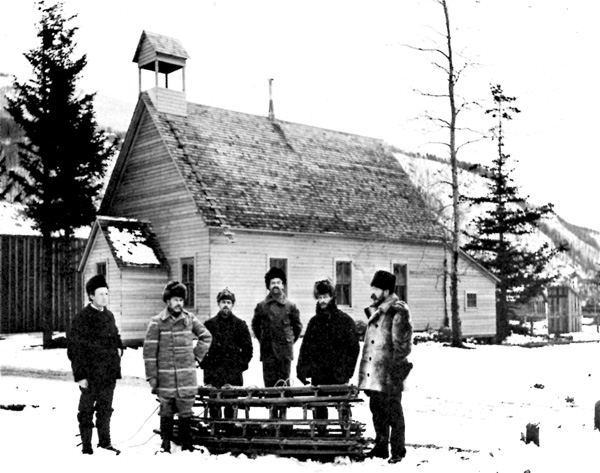
11 Revs. Dickey and Grant, Presbyterian missionaries at Skagway
en route to Klondike, January 1898.
(University of Washington.)
|
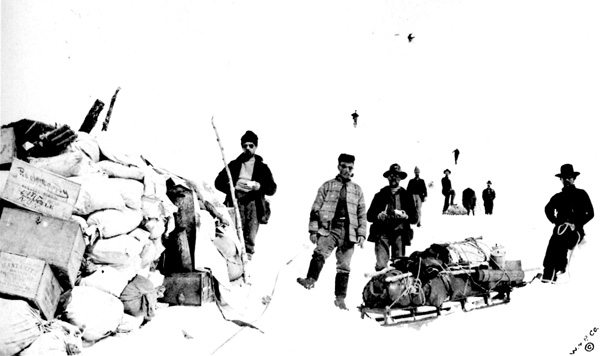
12 While these men are not Grant's party the size of their outfit
gives an idea of what the ordinary Klondiker brought "inside."
(Provincial Archives of British Columbia.)
|
Despite the difficulties, Grant's sense of mission
was strong. His parting address to the civilized world reveals a
determination to succeed in the north: "When the Superintendent faced me
with the question 'will you go to the Klondike?' every personal and
selfish consideration said 'No!' but all that was best in me said 'Yes!'
But I would not go, were I not overwhelmingly convinced that I am
called."11 An impartial observer would have found his
attitude refreshing, for many have commented on "cold-bloodedness of
the gold-seeking multitude"12 found around Lake Bennett in
the winter of 1897-98.
On 28 February, Grant informed Robertson that "Those
who ought to know affirm that Bennett will have a large population this
summer."13 Even at that time, men were braving the searing
chill of Yukon winter to travel downriver by sled (Fig. 13). Few would
stop for long at Bennett until The melting ice signalled danger. Then,
there would be a back-up of men waiting for the shift to summer modes of
transportation. "I have selected a site for a Church in Bennett and
think of ordering a large tent and erecting it on this site, put a block
floor in, and a sort of framework to support the tent. We must occupy
this post at once,"14 wrote Grant to Robertson. He evidently
expected there would be a large influx.
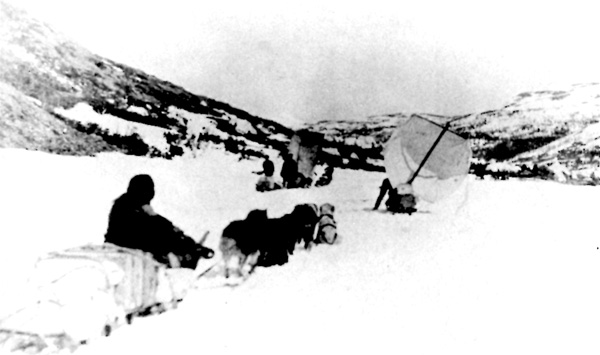
13 During the winter men traveled on Lake Bennett by sled, continuing
their journey.
(R.N. DeArmond, Juneau.)
|
By the middle of March, Grant had built a 12 by 16
foot log cabin as a residence or "manse," as he called it, to act as
shelter from the cold. He paid gold-rush prices for his supplies, and
although he cut the logs himself, the building cost over $200 to complete.
"For three short boards for a door I paid $9.00. For the tar paper for
the roof $21.00 &c."15 (Fig. 15). Gold-rush prices were
high, and Grant was on a normal salary. It is a tribute to his
dedication that he borrowed money to complete the work he felt
necessary and promised to pay it back himself if the
church did not consider it a worthwhile investment.16
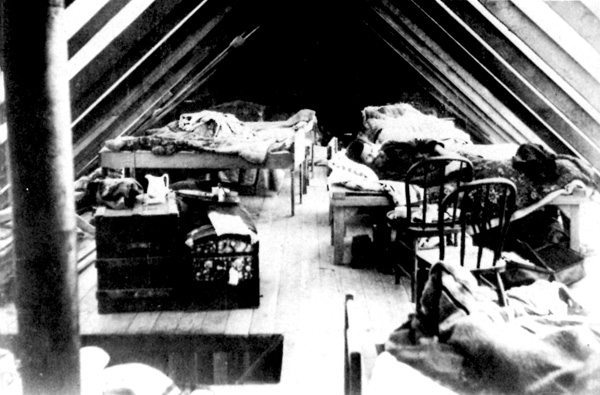
14 Hotel Dormitory. Two men to a bunk of split slabs and blankets
that smelled like axle grease.
(Sinclair Papers.)
|
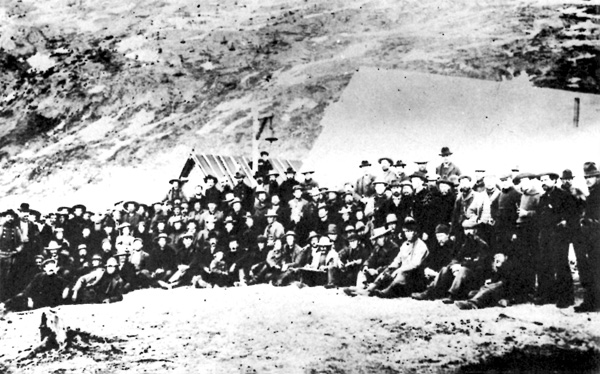
15 The congregation at a church service in the spring of 1898.
Note Grant's "manse" in the background on the left, the tent
church on the right, and the bell and scaffold in between.
(Public Archives Canada.)
|
Grant was finding little support among the
Klondikers. Earlier, on his way up the trail, he had commented on their
disinterest in the establishment of a church. In the Klondike "Gold is
God" recalled another man looking back on his experiences,17
and Grant found it was a vicious competitor. On 28 February he wrote to
Robertson, "I tried to conduct services at bunk houses along the way but
with little success."18 In these canvas or poorly chinked log
houses, two or three men squeezed on a single bunk of split slabs to
restoke for the day ahead19 (Fig. 14). They slept in shifts,
mindless of the stench and discomfort in their push north to the
gold-fields. "Most of the people work on the Sabbath," continued Grant,
"and it is difficult to interest them in Christian work. A man requires
much of the grace of God to sustain him in the midst of difficulties of
exposure and all such like, perhaps when we get down to work it will be
easier."20 But the first three services held in the new "St.
Andrew's Manse" in Bennett attracted only 30 people of varying
denominations. They "were comfortably seated on logs laid across blocks
of wood, and the logs were up held and stored with my blankets and
sleeping bag under them."21 Still, the collection of $5.00
did little to finance the construction of the building — a measure
traditionally used to evaluate the success of the work.
A subscription fund for the new St. Andrew's
Presbyterian Church, Lake Bennett, had nevertheless been started, and by
29 March, Grant was able to report, "so far as I have gone with the
Manse and Church everything is paid for." This may have satisfied
readers at home, but Grant himself was much less certain about the
venture. "I am sure that short of my medical mission work the manse . .
. would not have been an accomplished fact," he wrote. In the brutal,
competitive Klondike situation, Grant applied his practical talents as
a medical doctor to yield the slim margin he obviously felt was
essential for continuation. "I got a number to subscribe small amounts
and then having had occasion to treat a great many patients (some days
as many as 15) when asked my fee, asked a subscription."22
Still, the mission at Bennett, the first of a series in Canadian
territory, was in operation by March 1898.
|

